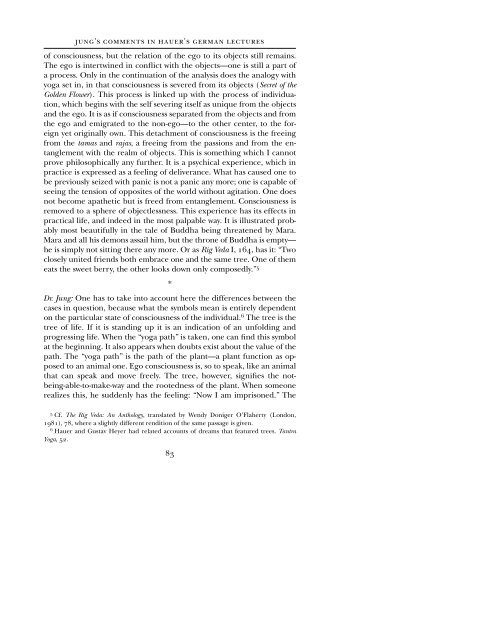CG JUNG - Countryside Anarchist
CG JUNG - Countryside Anarchist
CG JUNG - Countryside Anarchist
You also want an ePaper? Increase the reach of your titles
YUMPU automatically turns print PDFs into web optimized ePapers that Google loves.
<strong>JUNG</strong>'S COMMENTS IN HAUER'S GERMAN LECTURES<br />
of consciousness, but the relation of the ego to its objects still remains.<br />
The ego is intertwined in conflict with the objects—one is still a part of<br />
a process. Only in the continuation of the analysis does the analogy with<br />
yoga set in, in that consciousness is severed from its objects (Secret of the<br />
Golden Flower). This process is linked up with the process of individuation,<br />
which begins with the self severing itself as unique from the objects<br />
and the ego. It is as if consciousness separated from the objects and from<br />
the ego and emigrated to the non-ego—to the other center, to the foreign<br />
yet originally own. This detachment of consciousness is the freeing<br />
from the tamas and rajas, a freeing from the passions and from the entanglement<br />
with the realm of objects. This is something which I cannot<br />
prove philosophically any further. It is a psychical experience, which in<br />
practice is expressed as a feeling of deliverance. What has caused one to<br />
be previously seized with panic is not a panic any more; one is capable of<br />
seeing the tension of opposites of the world without agitation. One does<br />
not become apathetic but is freed from entanglement. Consciousness is<br />
removed to a sphere of objectlessness. This experience has its effects in<br />
practical life, and indeed in the most palpable way. It is illustrated probably<br />
most beautifully in the tale of Buddha being threatened by Mara.<br />
Mara and all his demons assail him, but the throne of Buddha is empty—<br />
he is simply not sitting there any more. Or as Rig Veda I, 164, has it: “Two<br />
closely united friends both embrace one and the same tree. One of them<br />
eats the sweet berry, the other looks down only composedly.” 5<br />
*<br />
Dr. Jung: One has to take into account here the differences between the<br />
cases in question, because what the symbols mean is entirely dependent<br />
on the particular state of consciousness of the individual. 6 Thetreeisthe<br />
tree of life. If it is standing up it is an indication of an unfolding and<br />
progressing life. When the “yoga path” is taken, one can find this symbol<br />
at the beginning. It also appears when doubts exist about the value of the<br />
path. The “yoga path” is the path of the plant—a plant function as opposed<br />
to an animal one. Ego consciousness is, so to speak, like an animal<br />
that can speak and move freely. The tree, however, signifies the notbeing-able-to-make-way<br />
and the rootedness of the plant. When someone<br />
realizes this, he suddenly has the feeling: “Now I am imprisoned.” The<br />
5 Cf. The Rig Veda: An Anthology, translated by Wendy Doniger O’Flaherty (London,<br />
1981), 78, where a slightly different rendition of the same passage is given.<br />
6 Hauer and Gustav Heyer had related accounts of dreams that featured trees. Tantra<br />
Yoga, 52.<br />
83


